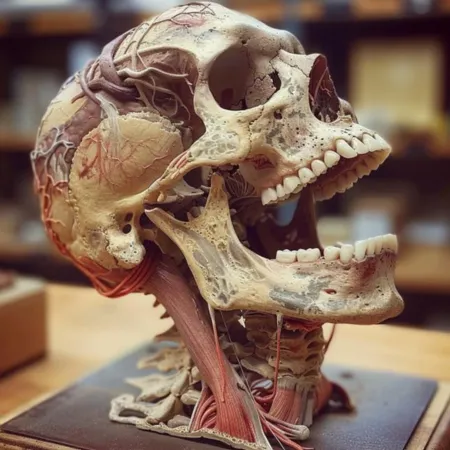This blog will tell you what’s going on inside your throat, the part that’s called the voice box.
Think of it like a machine that makes sounds for you to speak. Let’s find out where it is and why it’s important.
Key Takeaways
– The voice box sits at your windpipe between your chin and chest bones.
– Muscles and bands hold your voice box in place, like a swing, to keep it working well.
– Inside this box are vocal cords, tiny flaps that vibrate with air to make your voice!
– When you talk or sing, your voice box controls airflow, like a conductor adjusting the music.
– It also acts like a lid during swallowing to keep food and drinks out of your windpipe.
– Your voice box has parts like the Adam’s apple and vocal cords, which help it work.
– To keep your voice healthy, avoid straining it or smoking.
Where Is The Voice Box Located?
Ever wonder how you make sounds when you talk? It happens in your throat, but what’s there? Let’s find out about your voice box!
1. Position Of The Voice Box (Larynx)
Your throat is busy with important structures like muscles, blood vessels, and an air tube (windpipe).
Now, put your hand on your throat and swallow. Feel that bump moving? That’s your voice box or larynx!
It’s located between your chin and chest bones, and it helps you make sounds when you talk.

Ever wonder how you talk and sing? It all happens thanks to a neat part in your throat! This part is called a voice box or larynx.
Like a speaker makes sounds, your voice box lets you make noises when you talk or sing.
2. Position Of Larynx Within The Neck
You might wonder how the voice box stays in your throat. It’s like a tiny swing hanging on vocal cords!
The vocal cords are muscles and stretchy bands that hold the voice box in place, acting like anchors.
According to Anatomy, Head, and Neck: Larynx, the voice box (larynx) sits in the front of the neck and helps you breathe and talk.
It’s made of tough pieces like cartilage and is about the size of a ping-pong ball.
Even though the voice box seems small, many little parts work together to keep it right where it needs to be.
4. Importance Of The Larynx’s Location
Your voice box helps you sound good and keeps you safe while you eat and drink.
Your voice box is crucial for talking! It’s like the leader of your voice team, taking orders from your brain to produce sounds.
Function Of The Voice Box
How do we make sounds with our voices? Let’s learn about the cool mini-instrument inside us that helps us talk, called the voice box!
1. Role Of The Larynx In Producing Sound
When you talk or sing, air travels from your lungs up a tube to a special box.
This box is called your voice box; inside it are tiny folds called vocal cords.

When you’re quiet, your vocal cords are relaxed, and air moves freely through them.
But when you want to speak, your brain tells your voice box to tighten the vocal cords.
As air squeezes through these tight folds, they vibrate fast, making sound waves. These sound waves are your voice!
2. Regulation Of Airflow During Speech
Like a conductor for an orchestra, the voice box tells your vocal cords how tight to be and how much space to open.
This changes how much air flows through, making your voice soft or loud, high or low pitched!
It’s all happening inside you, just like adjusting the sound on a stereo.
3. Protection Of The Airway During Swallowing
Our voice box does awesome things! It helps us speak and stops food from going the wrong way, like a traffic officer.
When we swallow, our voice box moves up like a lid, closing the air tube.
This keeps food and drinks away from our lungs, which is very important.
Anatomy Of The Voice Box
The larynx is a small part of the body that allows us to talk, sing, and swallow. Let’s examine how it works.
1. Cartilages Of The Larynx
Imagine the larynx as a tiny cartilage playground!

Your throat has several important pieces, like cartilage, that act like a frame. These include:
– The Adam’s apple, which most people know, even though women have it too!
– The cricoid cartilage is strong and sturdy.
– The arytenoid cartilages are flexible and help you move your voice box.
These pieces hold everything together and help you make all sorts of sounds with your voice.
2. Vocal Cords And Their Function
Ah, the stars of the show – the vocal cords! Picture them as tiny, flexible bands stretched across the larynx.
When we speak or sing, these cords come to life, vibrating as air passes through, creating the magic we call sound.
It’s like a perfectly choreographed dance but in our throats!
Common Issues Related To The Voice Box
We all use our voices, but knowing how to avoid problems and keep them working well is helpful.
1. Voice Disorders
A sore throat that makes your voice raspy could be laryngitis (Vocal Disorder).
It happens when your voice box gets irritated, often from a cold, yelling too much, or breathing in smoke.

Singers can also develop little bumps on their vocal cords from overuse. These bumps make their voices hoarse and hard to use.
The good news is most cases go away on their own if you rest your voice and drink plenty of fluids. So take it easy and sip soothing honey tea.
2. Smoking And Other Factors
Smoking hurts your voice! It makes your throat scratchy, gives you more mucus, and can even cause cancer.
Drinking too much alcohol, breathing dirty air, and yelling a lot can also damage your vocal cords and make them raspy.
So how do we fix it? If you smoke, quitting is the best thing for your voice. Get an air cleaner and talk quieter inside.
3. Proper Vocal Hygiene And Care
Take care of your voice like you would a butterfly! Here’s how:
– Drink lots of water: This keeps your vocal cords nice and moist like butterflies need water to live.
– Warm up your voice: Before singing or talking, exercise gently to get your voice ready.
– Take breaks: Don’t talk too much for too long. Give your vocals rest.
Conclusion
There’s a small box called the voice box that lets you talk, sing, and even swallow your food.
Next time you talk, think about your amazing voice box! It helps you chat with friends, sing, and eat.
But that’s not all! It’s also a guard for your airway, keeping things healthy.
Take care of your voice box! Drink plenty of water, sing after a warm-up, and take breaks.
Resources For Further Study
– “The Human Voice” by Robert T. Sataloff Published By: Scientific American, a division of Nature America, Inc.
– “The Mechanism Of Human Voice” by Emil Behnke, Tonic Sol-fa College, London.
– “A view of the larynx through a new stroboscope “Robert West, University of Wisconsin.
- How To Keep The Conversation Going: 12 Expert Tips That Work - December 26, 2024
- Master Speech And Debate: 5 Essential Tips For Success - December 16, 2024
- 11 Communication Quotes To Inspire & Improve Conversations - November 20, 2024

Leave a Reply